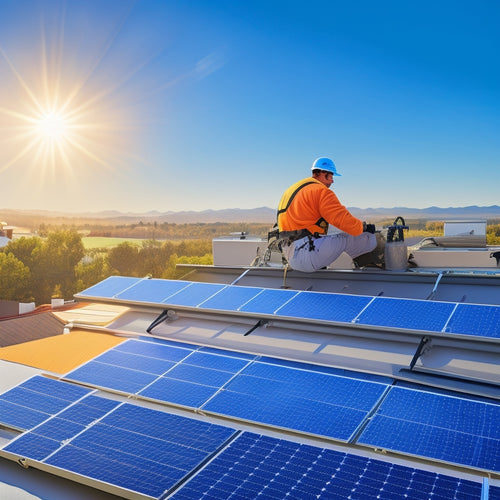
10 Essential Tips to Reduce Energy Monitoring Costs
Share
You can reduce energy monitoring costs by evaluating a combination of strategic practices. Start by analyzing your current energy expenditure through historical data analysis and utility bill reviews. Choose a monitoring platform that aligns with your goals and prioritize key performance indicators. Optimize data transmission by balancing real-time needs with cost-effective schedules. Select cost-effective hardware and leverage free or open-source tools to save costs. Implement energy efficiency measures, reduce false alarms, and automate reports. By implementing these essential tips, you'll be on your way to cutting energy monitoring costs – and there's more to explore to maximize your cost savings.
Key Takeaways
• Analyze utility bills and conduct energy audits to identify areas of inefficiency and opportunities for cost reduction.
• Choose cost-effective hardware with low power consumption and prioritize quality, compatibility, and scalability.
• Implement energy efficiency measures such as upgrading to energy-efficient equipment and implementing smart building technologies.
• Optimize data transmission by aggregating and compressing data, and scheduling transmission during off-peak hours.
• Leverage free or open-source tools to reduce software costs and allocate resources to essential components.
Assess Current Energy Monitoring Costs
To accurately reduce energy monitoring costs, you must first quantify your current expenditure by gathering historical data on your energy consumption patterns, utility bills, and existing monitoring system expenses. This pivotal step allows you to understand your energy usage habits and identify areas of inefficiency.
Conducting an energy audit is a great way to gather this data, as it provides a detailed analysis of your energy consumption and highlights opportunities for improvement. By examining your utility bills, you can identify trends and patterns in your energy usage, which will help you pinpoint areas where you can cut back.
Cost benchmarking is another essential step in evaluating your current energy monitoring costs. This involves comparing your energy consumption and costs to industry benchmarks or similar organizations, helping you identify areas where you're overspending. By gathering this data and conducting a thorough analysis, you'll be able to pinpoint areas for improvement and develop a plan to reduce your energy monitoring costs effectively.
Choose the Right Monitoring Platform
When selecting a monitoring platform, you'll want to prioritize features that align with your energy monitoring goals. By comparing the features of different platforms, you'll be able to identify the one that best fits your needs.
Next, you'll need to define key performance indicators (KPIs) to measure the platform's effectiveness in reducing energy monitoring costs.
Platform Features Comparison
By evaluating the features of different energy monitoring platforms, you can identify the most cost-effective solution that meets your specific needs and reduces energy monitoring costs. A thorough comparison of platform features is important to make sure you're getting the best value for your investment.
Here are some key features to take into account:
-
User experience: Does the platform provide an intuitive and user-friendly interface that allows you to easily navigate and access energy usage data?
-
System integration: Can the platform seamlessly integrate with your existing systems, such as building management systems (BMS) or supervisory control and data acquisition (SCADA) systems?
-
Data analytics: Does the platform offer advanced data analytics capabilities to help you identify areas of energy inefficiency and opportunities for improvement?
- Scalability: Will the platform grow with your organization, accommodating increasing energy monitoring needs and expanding to new locations?
Key Performance Indicators
You need to define and track key performance indicators (KPIs) that align with your energy monitoring goals to guarantee the chosen platform delivers the desired outcomes. By doing so, you'll be able to measure the platform's effectiveness in helping you achieve your energy targets.
Identify the performance metrics that matter most to your organization, such as energy consumption, cost savings, or carbon emissions reduction. Establishing clear KPIs will enable you to track progress, identify areas for improvement, and make data-driven decisions.
When selecting a monitoring platform, make sure it can track and report on your chosen KPIs. Look for platforms that offer customizable dashboards and reports, allowing you to visualize your energy performance metrics in real-time. This will enable you to quickly identify trends, anomalies, and opportunities for optimization.
Optimize Data Transmission Frequency
As you work to optimize your energy monitoring system, you'll want to carefully consider your data transmission frequency. You need to strike a balance between getting the data you need in real-time and avoiding unnecessary transmissions that drive up costs.
Real-Time Data Needs
Your energy monitoring system generates a vast amount of data, and optimizing data transmission frequency is essential to reduce the costs associated with real-time data needs. You need to strike a balance between data quality and transmission frequency to avoid information overload.
If you transmit data too frequently, you'll incur higher costs, but if you transmit too infrequently, you might miss critical insights.
To optimize data transmission frequency, consider the following:
-
Prioritize critical data points: Focus on transmitting data that's critical to your energy monitoring needs, and reduce the frequency of non-essential data transmission.
-
Use data aggregation: Aggregate data at the edge or in the cloud to reduce the amount of data transmitted, while maintaining data quality.
-
Implement data compression: Compress data to reduce the amount of data transmitted, minimizing costs without compromising data quality.
- Schedule data transmission: Schedule data transmission during off-peak hours or when network traffic is low to reduce costs.
Optimal Transmission Schedules
In addition, by optimizing transmission schedules, energy monitoring systems can greatly reduce costs associated with real-time data transmission, and smart scheduling can help achieve this goal.
You can achieve significant savings by adjusting the frequency of data transmission to match your specific energy monitoring needs. This is particularly important when dealing with high-volume data streams or large-scale energy monitoring systems.
To get the most out of your transmission schedule, focus on achieving the right balance between data freshness and transmission latency. By doing so, you can minimize the amount of data being transmitted, reducing the associated costs.
Additionally, having schedule flexibility allows you to adapt to changing energy monitoring requirements, ensuring you're only transmitting data when it's necessary.
Data Compression Techniques
You can further reduce energy monitoring costs by leveraging data compression techniques to minimize the amount of data being transmitted, thereby optimizing data transmission frequency. By compressing data, you can greatly decrease the amount of data sent over the network, resulting in lower energy consumption and costs.
Here are some ways to apply data compression techniques:
-
Lossless algorithms: Implement lossless algorithms, such as Huffman coding or arithmetic coding, to compress data without losing any information. These algorithms reduce data size while preserving its original content.
-
Data encoding: Use data encoding techniques, like delta encoding or run-length encoding, to represent data in a more compact form. This reduces the number of bits required to transmit data, leading to energy savings.
-
Data filtering: Apply filters to remove unnecessary data, reducing the amount of data transmitted and energy consumed.
- Compression ratios: Optimize compression ratios to balance data compression and decompression times, ensuring efficient data transmission and energy savings.
Select Cost-Effective Hardware Options
Selecting cost-effective hardware options for energy monitoring systems necessitates careful evaluation of device capabilities, communication protocols, and integration requirements to guarantee seamless data transmission and analysis. You must consider factors such as hardware quality, energy compatibility, and scalability to make sure that your system operates efficiently.
When choosing hardware, prioritize devices with high-quality components that can withstand the demands of continuous energy monitoring. Look for devices with low power consumption and reliable data transmission capabilities. Energy compatibility is also vital, so make certain that your hardware is compatible with your energy sources and systems.
Furthermore, consider the scalability of your hardware options. As your energy monitoring needs grow, your hardware should be able to adapt and expand accordingly.
Leverage Free or Open-Source Tools
To minimize energy monitoring costs, utilizing free or open-source tools can be a cost-effective strategy, allowing you to allocate resources to other essential system components. By leveraging these tools, you can reduce your energy monitoring costs without compromising on performance or functionality.
Here are some benefits of using free or open-source tools for energy monitoring:
-
Cost savings: Open source software can greatly reduce your energy monitoring costs, allowing you to allocate resources to other essential system components.
-
Customization: Open source software provides you with the flexibility to customize the tool to meet your specific energy governance needs.
-
Community support: Open source software often has a large community of users and developers who contribute to the software, providing support and updates.
- Scalability: Open source software can be scaled up or down to meet your energy monitoring needs, making it an ideal solution for organizations of all sizes.
Monitor Energy Production in Real-Time
Real-time energy production monitoring enables instantaneous tracking of energy output, allowing for swift identification of inefficiencies and prompt corrective actions to optimize energy production.
You can't afford to wait for monthly or quarterly reports to identify issues - with real-time monitoring, you'll be alerted to problems as they happen, enabling you to take corrective action immediately.
This essential approach is vital for achieving energy independence, where every kilowatt-hour counts. By monitoring energy production in real-time, you'll be able to pinpoint areas of inefficiency and make data-driven decisions to optimize your energy output.
This is especially important in smart grids, where real-time monitoring enables the efficient distribution of energy. With real-time monitoring, you'll be able to identify opportunities to reduce energy waste, optimize energy production, and make informed decisions about energy distribution.
Implement Energy Efficiency Measures
By integrating energy-efficient technologies and optimizing system design, you can greatly reduce energy waste, minimize environmental impact, and cut energy monitoring costs. This not only helps you save money but also contributes to a more sustainable future.
To achieve this, consider the following energy efficiency measures:
-
Conduct regular Energy Audits to identify areas of improvement and optimize energy usage.
-
Upgrade to energy-efficient equipment and lighting systems to reduce energy consumption.
-
Implement smart building technologies that can learn and adapt to your energy usage patterns, optimizing energy consumption and reducing waste.
- Set and track Sustainability Goals to make certain your organization is meeting its environmental commitments and reducing its carbon footprint.
Reduce False Alarms and Notifications
You can greatly reduce energy monitoring costs by minimizing false alarms and notifications that often result from incorrect or incomplete data, which can lead to unnecessary maintenance and troubleshooting efforts.
False alarms can be particularly problematic, as they can lead to alarm fatigue, where personnel become desensitized to alerts and ignore critical issues.
To reduce false alarms, you should implement robust notification filters that weed out irrelevant data and prioritize critical notifications.
Automate Energy Monitoring Reports
When you automate energy monitoring reports, you'll have real-time access to your energy data, enabling you to make informed decisions quickly.
With customizable report templates, you can tailor your reports to suit your specific needs, whether that's tracking energy consumption or identifying areas for improvement.
Real-time Data Access
Having real-time access to energy monitoring data enables you to receive instantaneous alerts and notifications, allowing swift response to anomalies and deviations from expected energy usage patterns. This immediate insight into your energy consumption empowers you to make data-driven decisions, reducing energy waste and optimizing your energy management strategy.
With real-time data access, you can:
-
Identify opportunities for energy efficiency improvements through advanced data analytics, providing actionable Energy Insights to optimize your energy usage.
-
Pinpoint energy-intensive areas in your operations, enabling targeted interventions to reduce energy consumption.
-
Automate energy monitoring reports, streamlining your reporting process and freeing up resources for more strategic activities.
- Enhance predictive maintenance by detecting potential equipment failures, reducing downtime, and minimizing energy losses.
Customizable Report Templates
Customizable report templates streamline your energy monitoring report generation, allowing you to effortlessly create tailored reports that meet specific stakeholder requirements and regulatory needs.
With template customization, you can automate energy monitoring reports, saving you time and resources. You'll no longer need to manually collect and format data, reducing the risk of errors and inconsistencies.
Negotiate With Energy Monitoring Providers
You can significantly reduce energy monitoring costs by bargaining with providers, as many are willing to offer discounts or tailored plans to loyal customers or those committing to long-term contracts. By leveraging your vendor relationships, you can access better pricing and more flexible service agreements.
Here are some key considerations to keep in mind when negotiating with energy monitoring providers:
-
Vendor Leverage: Use your company's purchasing power to negotiate better rates or customized plans that meet your specific energy monitoring needs.
-
Service Flexibility: Collaborate with providers to create tailored service agreements that offer flexible pricing, scalable solutions, and adaptable data analytics to meet your evolving energy monitoring requirements.
-
Long-term Commitments: Consider committing to multi-year contracts to secure discounted rates or priority support from your energy monitoring provider.
- Customized Solutions: Negotiate for customized solutions that cater to your specific industry, facility type, or energy monitoring requirements, ensuring you only pay for the services you need.
Frequently Asked Questions
What Are the Common Energy Monitoring Costs That Can Be Reduced?
As you explore energy monitoring costs, you'll uncover hidden expenses, like Inefficient Systems draining your budget. Prepare to be surprised by the impact of inadequate Energy Audits, revealing opportunities to slash unnecessary expenditures and optimize your energy usage.
Can Energy Monitoring Costs Be Reduced for Small-Scale Operations?
You can greatly reduce energy monitoring costs for small-scale operations by focusing on operational efficiency, which leads to substantial cost savings, allowing you to allocate resources more effectively and improve your bottom line.
How Often Should Energy Monitoring Data Be Reviewed for Optimization?
As you aim for energy efficiency, you'll want to review energy monitoring data regularly, ideally in real-time, to pinpoint areas for optimization, leveraging granular data to identify peak usage and make informed decisions.
Are There Any Energy Monitoring Costs Associated With Data Storage?
As you consider energy monitoring costs, you'll find that data storage expenses can add up, especially with Cloud Pricing models that charge by data volume, making Data Inflation a critical concern to keep costs under control.
Can Energy Monitoring Costs Be Reduced by In-House Management?
By leveraging in-house expertise, you can reduce energy monitoring costs by taking ownership of energy accountability, allowing you to identify areas of inefficiency and optimize energy usage, which ultimately leads to significant cost savings.
Related Posts
-

Charging Points in Rural Areas: 5 Key Insights
When driving through rural areas, you'll face a shortage of charging points, making EV ownership stressful and inconv...
-

What Are the Average Cost Savings of Solar Panels
You can expect to save between $400 and $1,000 per year on your electricity bills with solar panels, which translates...
-

3 Essential Steps for Solar Electricity Installation
To guarantee a successful solar electricity installation, you'll need to follow three essential steps. First, assess ...


